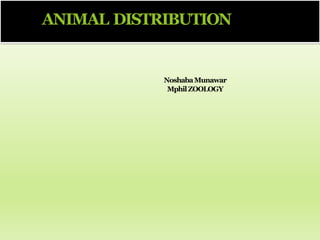
Barriers of dispersal
- 2. BARRIERS TO DISPERSAL • External factors which limit the dispersal or distribution of organisms are called barriers. • Barriers are always relative because a barrier for one group of animals may be a means of dispersal for another. • The barriers have not remained constant in geological past.
- 3. • Land masses and seas have shifted their position, providing either means of dispersal or creating barriers. • Thus groups of animals became extinct, isolated or evolved into new species. • For example, there are no wild camels in North America today but their fossil record suggest that in the geological past they were widely distributed throughout NorthAmerica.
- 4. TYPES OF BARRIERS • Barriers may be classified into three main categories: 1. Physical Barriers 2. Climatic Barriers 3. Biological Barriers
- 5. 1. PHYSICAL BARRIERS • The main physical barriers may be discussed under the following headings: a) Mountains b) Water bodies c) Deserts
- 6. a. MOUNTAINS • High mountain ranges are effective topographic barriers, which prevent the animaldispersal. • Himalayan mountain range is an effective barrier between India and Eurasia. • On southern side, moist hot plains of India have elephants, rhinoceros, tigers, deer and peacock,etc. • On northern side, climate is temperate and the fauna includes animals like oxen, sheep, pigs, hyenas,etc.
- 8. b. WATER BODIES • Large water bodies like vast oceans or sea channels form notable barriers to the distribution of amphibians, reptiles and mammals. • Mozambique Channel which separates Madagascar Island from its main land Africa, is only 40 km wide, yet the fauna of the two regions is quite different. • Modern amphibians and freshwater fishes are prevented from dispersal by large bodies ofsaltwater. • For birds and bats, water bodies are not barriers todispersal.
- 10. c. DESERTS • Extensive hot and dry desert of the world are an effective barrier to the animals which are unable to survive under such a hostile conditions. • Sahara desert forms an area of demarcation between Ethiopian and Palaearctic region. • In the south animals like gorilla, zebra, giraffe, elephant and rhinoceros are present. • In the north mammals like goats, pigs and oxen are present. • Kalahari desert is responsible for the distinctive fauna of Central Africa from that of Cape of Good Hope.
- 12. 2. CLIMATIC BARRIER S • The climatic barriers include all the abiotic factors which control the survival and dispersal of animals. The main factors are: a) Temperature b) Humidity c) Light
- 13. a. TEMPERATURE • The lowest recorded temperature on the earth is about - 126.9 F° and the highest is 136.4 F°. • Variability in thermal values is an important limiting factor that effects the distribution of animals. • Cold-blooded animals are not found on the poles. Amphibians and reptiles are abundant in the tropics. Their diversity and number decrease as we move from temperate regions to the poles. • Temperature has a direct effect on growth and diversity of vegetation, which in turn effects the distribution of various animal groups.
- 14. b. HUMIDITY • Some animals are found only under very humid conditions while others prefer dry habitats. • Many subterranean species like centipedes and millipedes are found only in damp soil and can not survive if exposed to dry air for long time. • Likewise, the increase in moisture renders a region unsuitable for the species which are adapted to dry habitat.
- 15. c. LIGHT • Light directly affects several activities of animals like growth, locomotion, migration and dispersal. • Light has a profound effect on aquatic habitat. • Light penetration in water bodies affects the distribution of plants and consequently the distribution of animals. • In lakes and oceans, copepods and zooplanktons exhibit circadian rhythms by showing diurnal changes in their vertical distribution. • On land, the light has an indirect effect on animal dispersal since it controls the growth and variety of vegetation.
- 16. 3. BIOLOGICAL BARRIERS • The biological barriers include: a) Effect of vegetation type on animal dispersal. b) Effect of various interactions among animal groups on their dispersal.
- 17. a. VEGETATION • Vegetation effects the distribution of animals directly as well as indirectly. • Plants not only provide food to animals but specific types of habitats also. • The animals present in forests, grasslands, deserts, are adapted to their particular habitat. • European crested tits, for example, live only in Coniferous trees and many kinds of insects are dependent on particular species of plants for their food.
- 18. MONOPHAGIC SPECIES • Some animal species are called Monophagic, i.e., feeding on a single type of food only. • Panda lives in a forest and feeds on young bamboo shoots only. • Koala bear lives in Australia and feeds upon Eucalyptus leaves only. • Monophagic species would not survive if their food is not available.
- 19. • Lack of vegetation limits the distribution of many animals very efficiently. • Many primates (monkeys, gibbons, chimpanzees, etc.) inhabit forests where trees serve them to provide food, shelter and an efficient mode of locomotion. • The dense forests which are impassable for large ungulates and act as an effective barrier for dispersal. • For arboreal animals open grasslands act as effective barrier for their dispersal.
- 20. Koala feeds upon Eucalyptus leaves only. Panda feeds on young bamboo shoots only.
- 21. b. ANIMALS • Various types of interactions among different groups of animals also regulate their dispersal. Such as : a) Animals prey on one another. A carnivore (predator) may destroy a herbivore population completely. b) Animals parasitize one another. Many parasites regulate the dispersal and perpetuation of their host species. c) Animals compete with each other for food space, breeding or nesting sites etc.
